On July 21st, I took the 271 horse powered engine Hyundai Sonata 2.0 Turbo for about an hour around Paju, KyungKi-do. Commonly for a 2.0 liter turbo car, it mostly is packed with about 200 horsepower under the hood. In fact, all of the new high-performance cars that Volkswagen or Audi have launched have a 2.0 liter engine with 210 horsepower.
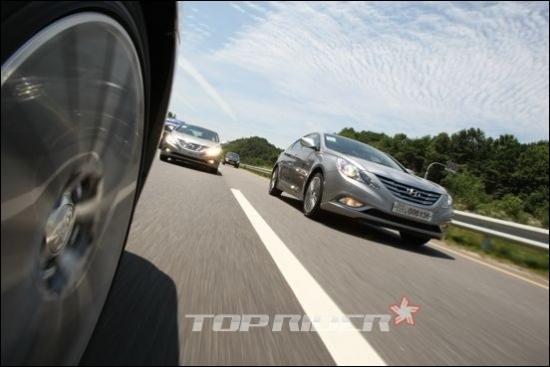
However, Hyundai launched their 2.0 turbo engine with an impressive 271 horsepower, which exceeds the common standards. This model is compared frequently with the Mitsubishi sports car Lancer Evolution (equipped with 290 horsepower). The Lancer Evolution is a high-performance sports car that has an engine that is known for needs constant care by the owner. I was able to feel what it’s like to really have a 271-horsepower engine in a popular car like the Sonata.
◆Not a power-sucking Turbo, but an economical car with high-performance
Before the revealing, the fans had high expectations for this car because they thought they finally found a car with high-performance that can be called sports sedan. When I looked at the actual car, I thought that they could be disappointed not because of its performance, but because of the setting.
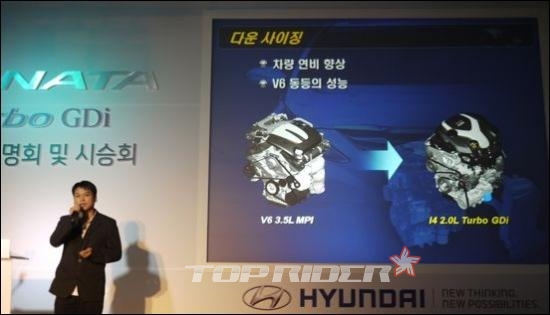
According to an official who developed the turbo engine, the direction that this car aims is not upgrading the existing Sonata 2.0 to make it more powerful, but downsizing the car that was supposed to have V6 3.5 liter engine. So consequently, the exhaust sound was extremely inhibited, and suspension, output, and shifting were tweaked to be able to match up with other high-quality sedans. In other words, the 2.0 liter Turbo Sonata is not targeting the young fans, but it is targeted for a middle-aged crows that is interested in the economical efficiency and performance.
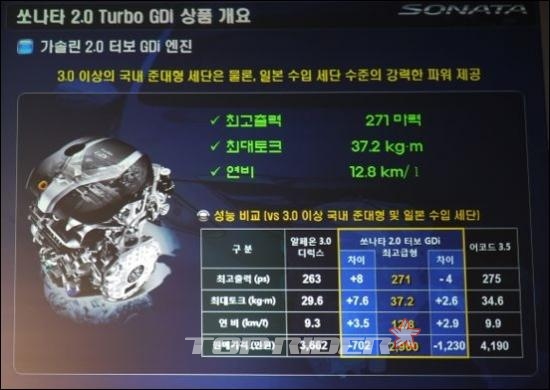
In fact, 2.4 liter GDI model will cease production with this launching of the Sonata Turbo, and 3.0 liter GDI engine does not have a big difference in performance, so it would affect in the volume of sales.
◆Driving the Sonata Turbo
Hyundai Motors disclosed that it takes seven seconds to accelerate up to 100km per hour. It has the best acceleration speed among Korean cars, but there is no exciting feeling to it. It was because there wasn't the power in the sound of the engine when accelerating. And it accelerated almost too smoothly. As someone who enjoys the thrill of speed, it was a sad to not feel the road under me.
To really put it into words, it felt like the car was riding on clouds. For those fans who prefer German high-performance cars, they'd feel sad about this, but for most consumers who pursue comfortable driving, this would be an advantage.
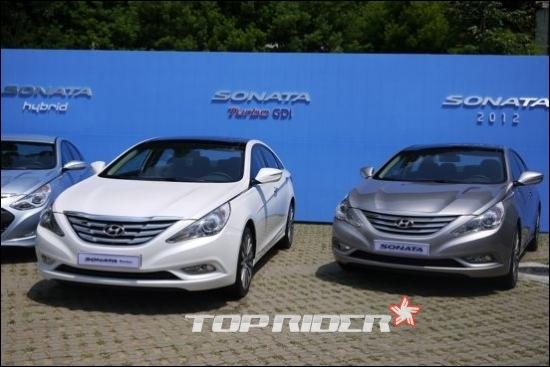
The back of the Sonata Turbo can't be distinguished from the general Sonata easily. The differences would be that there are two mufflers and that the inside of the tail lamps is a bit different.
Sonata's suspension is very smooth, catching all the small vibrations of the road, but it doesn't mean that it gives a vacillating feeling at all. When entering a corner, it tightly holds suspension. For this car's suspension the variable suspension, ASD, allows the car to respond according to the frequency of vacillation in the suspension.
If I stepped on the accelerator a bit hard, it shockingly, instantly shot up to 200 km per hour. After hitting 160km per hour, I wasn't confident in going any faster because I didn’t' feel that I could control the car perfectly. Since the body is quite big, it is not easy to control stably when driving in high speeds. The average drivers don't have many chances to drive at this speed, but hopes and desires are beginning to surge in me, for this to be able to develop as much as a German car. The response of sudden braking while driving is already considerably excellent, but since the performance of Korean cars are improving rapidly, there are many more developments to look forward to.
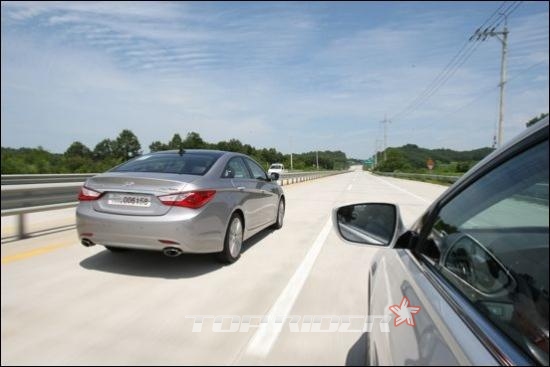
It is an irony that the grill of the newly launched Sonata Turbo is rather “classic”
When I turned off the Electronic Stability Program (ESP) and accelerated the car, there was a wheel spin with the screeching sound of the tires scraping the road. But, it was not a light sound that comes from Golf GTI or Audi A4. Sonata Turbo is made in a way that even if Electronic Stability Program (ESP) is turned off, if wheels slide, then it recognizes the danger and decreases torque on its own. By no means, since it is a typical Sonata, it is a bit overreaching to expect something tough like an aggressive screech or burning tires. There wasn't any torque steer (a phenomenon when the steering wheel turns on its own when accelerating a high-performing front-wheel-drive car), and it was set that it was easy to control in every aspect, in terms of safety.
◆2.0 liter turbo was installed in the Santa Fe first.
The 2.0 liter turbo engine, which was installed for the first time in a Hyundai car, has a great future. The online community or fans anticipate that it will be installed in the Genesis Coupe, making it perform even better.
First, Hyundai Motors decided to install a 2.0 liter turbo engine in the Santa Fe's 3.5 liter model that gets produced in America. But, in Hyundai Tucson IX, turbo won't be installed. According to a Hyundai Motors official, since the market for gasoline SUV in Korea is so small, there was no plan to develop gasoline turbo. For Kia Motors Sportage R, North American offices made a request as they guaranteed sufficient sales in the American market, so they began to develop a turbo engine, but there was no request from the North American offices for a turbo Tucson IX.

![[시승기] 아이오닉9, 532km 주행하는 6천만원대 전기차](https://www.kod.es/data/trd/image/2025/11/13/trd20251113000037.400x.0.jpg)
![[시승기] 아이오닉6N, 믿기지 않는 완성도의 스포츠카](https://www.kod.es/data/trd/image/2025/10/29/trd20251029000001.400x.0.jpg)
![[시승기] 기아 EV5, 패밀리 전기 SUV의 새로운 스탠다드](https://www.kod.es/data/trd/image/2025/09/24/trd20250924000001.400x.0.jpg)
![[시승기] 쏘렌토 하이브리드, 5천만원에 모든 것을 담았다](https://www.kod.es/data/trd/image/2025/09/15/trd20250915000001.400x.0.jpg)
![[시승기] 카니발 하이브리드, 대형 SUV 위협하는 상품성](https://www.kod.es/data/trd/image/2025/09/14/trd20250914000001.400x.0.jpg)
![[시승기] 아이오닉6 N라인, 세련된 전면부..단단해진 승차감](https://www.kod.es/data/trd/image/2025/08/29/trd20250829000013.400x.0.jpeg)
![[시승기] 기아 PV5 패신저와 카고, 준중형급 차체 중형급 공간](https://www.kod.es/data/trd/image/2025/08/20/trd20250820000024.400x.0.jpg)
![[시승기] 액티언 하이브리드, HEV 보다 EREV에 가깝다](https://www.kod.es/data/trd/image/2025/07/14/trd20250714000030.400x.0.jpg)
![[시승기] 팰리세이드 하이브리드 AWD, 고성능 하이브리드의 시작](https://www.kod.es/data/trd/image/2025/07/03/trd20250703000039.400x.0.jpg)
![[시승기] 제네시스 GV60 부분변경, 유일한 단점은 가격 책정](https://www.kod.es/data/trd/image/2025/07/03/trd20250703000001.400x.0.jpg)














![[시승기] 볼보 S90 T8, 플러그인 하이브리드 최강 가성비](https://www.kod.es/data/trd/image/2025/11/28/trd20251128000001.122x80.0.jpg)
![[시승기] 아이오닉9, 532km 주행하는 6천만원대 전기차](https://www.kod.es/data/trd/image/2025/11/13/trd20251113000037.122x80.0.jpg)
![[시승기] 푸조 3008 GT, 실연비 20km/ℓ..이쁘고 경제적](https://www.kod.es/data/trd/image/2025/10/31/trd20251031000001.122x80.0.jpg)
![[시승기] 아이오닉6N, 믿기지 않는 완성도의 스포츠카](https://www.kod.es/data/trd/image/2025/10/29/trd20251029000001.122x80.0.jpg)
![[시승기] 볼보 ES90, 이상적인 시트포지션과 승차감 구현](https://www.kod.es/data/trd/image/2025/10/23/trd20251023000001.122x80.0.jpg)
